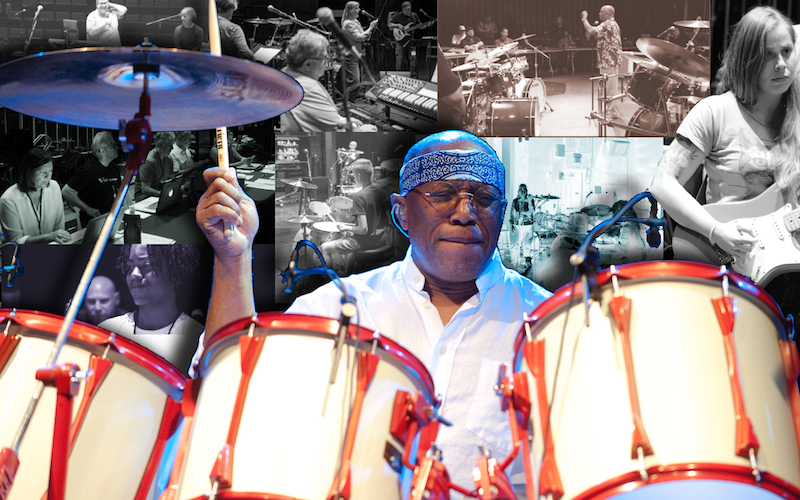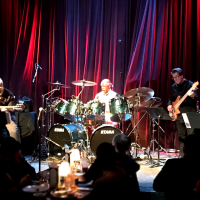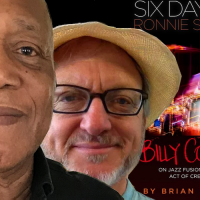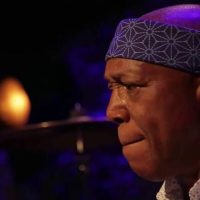
Photos courtesy of Billy Cobham
Billy Cobham’s Art of the Rhythm Section Retreat is returning to the Mesa Arts Center in Mesa, Arizona for the third year. Registration is now open for this special event, which is targeted at musicians, students, and educators; the retreat will be held between July 22 and July 28, 2018.
At the retreat, Cobham and a team of professional musicians coach other experienced players on how to improve their discipline across various tenets including building trust, controlling ideas, regulating tempo, and maintaining a harmonious musical character. The precepts that are covered are independent of musical styles: While Cobham is known as a jazz player, the retreat is about listening and being in sync with bandmates, while remaining in control of ideas and musical principles – regardless of one’s given musical idiom.
Retreat general manager Nancy Balik elaborated on the desired level of expertise of participants: “We’ve certainly seen a wide range of playing and rhythm section musicianship abilities within the parameters of high-intermediate to advanced students, music educators, semi-pros and working professionals. Most people – even those with long resumes and years of experience – are relatively new to these ideas and principles. Regardless of where they’re at when they arrive, invariably to some degree everyone leaves changed: They’ve grown and their eyes and ears – and minds – are more opened to the possibilities.”
When asked about feedback from the participants of previous retreats Balik revealed that many attendees have stated that the experience was “life-changing” and “transformational,” providing the following examples:
– A professional bass player who has gotten so much at such a deep level from the program that he’s returning for the third year in a row. He has written a lengthy evaluation demonstrating how much he has derived from the coaches, the culture of the experience, the camaraderie, and the teachings that have stayed with him.
– Several advanced young drummers aged 13-18 are returning for the second or third time, having found the program to be completely distinctive from other camps, training or musical experiences they’ve had during their musical education. They report that they’ve grown “immensely” and “tremendously” from this program.
– A college-level jazz educator who was so excited about his participation in the program that he has been trying to find a way to bring it to his university, and is thrilled that the program emphasizes teamwork, communications, and cohesiveness within the rhythm section. He says that this is not being taught at his university to this degree, and it’s the “missing piece.”
– A visually deficient and highly talented drummer from Brazil sold his drums so that he could participate last year, didn’t speak a word of English – but got so much from it that he’s attending again this year.
Balik explains that overall, “the reality is, people who come to the program discover and learn about themselves in unexpected ways. It’s a very deep experience, a process that may take years to fully understand and put into practice. Yet, we hear time and time again how much an individual’s playing has improved.”
What is it that compels attendees to return for subsequent retreats? “The principles of awareness and communications and mutual support that form the basis of Bill’s teachings, which he and the coaching team model and teach, are profound,” Balik explains. “One can spend a lifetime learning to master, which in part explains why participants return year after year.
“So, in answer to your question about why do people come back,” Balik adds, “it’s partly because they want to dig in deeper into the process, and go further in their understanding of themselves vis-à-vis the true art of the rhythm section, and become a better musician and team player with keener levels of awareness and cohesiveness. ‘Returning to the well,’ so to speak, is a way for the aspiring artist or the more seasoned musician alike to continue to evolve and grow within himself or herself and within the construct of the rhythm section, operating as a fully conscious member of a cohesive unit that supports each member and serves the music.”
While Nancy Balik’s comments on the retreat support the web site’s detailed data and accompanying videos, Billy Cobham graciously provided additional background and detail for the uninitiated.
MIKE TIANO: What gave you the idea for this retreat?
BILLY COBHAM: This idea was shared with me by the late, great Chris White, who ran a small school in New York City named Rhythm Associates back around 1966 through 1970, I believe. The premise was to expose young, interested musicians to the mysteries of rhythm section interaction through critical analysis and the general musical concepts of working professional musicians like Jimmy Owens, Ed Thigpen, Thad Jones, Grady Tate, Hubert Laws, Tom McIntosh, Roland Hannah, Billy Taylor and others. These meetings went a very long way in helping me develop my musical ideas and more.
MIKE TIANO: Why did you choose Mesa, Arizona as the location to conduct the retreat?
BILLY COBHAM: Mesa in the summer is ideal because the only people in town are those who choose to stay indoors with good reason. At the Mesa Arts Center, we work to better the skills of our participants with a well-planned syllabus for six days. It has always been intense, as well as fun. At the Art of the Rhythm Section Retreat, we focus upon the positive in music by providing examples of how to create and sustain all positive aspects that we encounter along the way in our quest.
MIKE TIANO: How did you get the first retreat off the ground, and who were the individuals who were instrumental in assisting you in doing so?
BILLY COBHAM: Over the past few years, I have met professionals who specialize in much of the supportive aspects of the entertainment business and in the world of the arts, in general. I have learned that in order to be successful one must have an ongoing working relationship with attorneys, accountants, public relations specialists and others of similar ilk in order to spread the word of your existence and what you seek to accomplish. Nancy Balik, Tony Berman, Faina Cobham, Dom Famularo have been with me since the beginning of this journey. They are at the core of the existence of the Art of the Rhythm Section Retreat. Through Gary Widman, who was working with me in a consultative position in the first year of the project, I was introduced to Randy Vogel – director at the Mesa Arts Center. With these people, I have been able to develop the project to the level that it is at today.
MIKE TIANO: How do you address the challenges associated with attendees whose musical interests span various musical idioms like jazz, punk, progressive, heavy metal, pop, dance, etc.?
BILLY COBHAM: When it comes to jazz, pop, rock and all of the musical sub groups associated those platforms, the foundational aspects are basically the same: controlling one’s sense of time, learning how to multitask [called poly-musical coordination], becoming more musically sensitive in the use of all elements musical. We begin at the beginning by playing simply but effectively.
MIKE TIANO: In past retreats, did you have any issues with players who attended who weren’t expert at their instrument?
BILLY COBHAM: Yes, we did, and we will probably make this encounter again, since it is common sense to most that if they invest in the program they will want me and my coaches to immediately prove that we are qualified to help and support those attending. I have had encounters with people who had developed musical facilities designed to outshine me by playing as loud, as fast and with reckless abandon. But what they did not bring to the retreat was a formula that showed that they knew how and when to use their skills. At the retreat, we can provide assistance in these areas through the video documentation of their daily progress at jam sessions and assigned collaborations with colleagues. At the Art of the Rhythm Section Retreat, it’s all about the music and how to effectively share it with the world as priority one.
MIKE TIANO: Have any famous or well-known players attended, and if so who were they?
BILLY COBHAM: In the first year [2016], George Benson stopped by and spent a few hours with us. Stanley Jordon lives in Arizona, so I invited him to come down and assist me with a master class. Aside from George and Stanley, my coaches were Dean Brown [guitar], Ric Fierabracci [bass], and Gerry Etkins [keyboards]. I have worked off and on with Dean and Gerry since the 1980s. Ric, I met on a Frank Gambale recording session at the turn of this century. We performed at the retreat in the first two years as Spectrum 40. This year, I have been very fortunate to have as guests Ron Carter [ex-bassist with Miles Davis], Kenny Barron [pianist with Dizzy Gillespie and Stan Getz], and Lee Oskar, my favorite “Harmonicat,” from the Low Rider Band.
My coaches for this year will be Paul Hanson [woodwinds], Fareed Haque [guitars], Scott Tibbs [keyboards], and Tim Landers [bass]. We will present a discussion and performance platform with Ron, Kenny and myself. We have performed from time to time in a trio as the Art of Three. The tag sets us up as the classic jazz trio, and provides much food for thought in our reflections on the past in comparison to the present state of instrumental music today. On day three, the Art of Three will hold a musical meeting of sorts in the auditorium of the Mesa Arts Center. It will be open to the public. All week, we will be looking at how the wheels of the rhythm section turn. The beauty of the experience is that everyone learns from the interactions generated over the full week. So, it’s definitely a win / win for all.
MIKE TIANO: What is the total number of slots you are filling, and approximately how many are left?
BILLY COBHAM: To maintain the right dynamics and fulfill our commitment to individualized attention to each participant-allowing adequate time for everyone to have a chance to play multiple times with the band and fellow participants, we aim to keep the number of participants to 36 – roughly 9 or 10 rhythm sections, including players of guitar, bass, keyboards, drums and woodwinds. Registration is filling up, but we have a few slots left for bass, guitar, keyboardists and woodwind players who are advanced students, music educators or semi-pros and working musicians. We offer music educators or students a special discount of 10 percent. Ask for details at: [email protected].
As Cobham noted above, there are remaining slots available for rhythm section instrumentalists. As of this posting these include bass, guitar, keys, and woodwinds; the drumming section, however, is now full. For more details please visit BillyCobhamRetreat.com; any questions not answered there can be addressed by emailing [email protected].
©2018 Mike Tiano. All Rights Reserved.
- Remembering Billy James: ‘He Was One of the Good Ones’ - May 15, 2025
- ‘Becoming Led Zeppelin’ (2025): Movie Review - March 11, 2025
- Grateful Dead’s Kennedy Center Honors: What Was Missed - January 27, 2025




